This post contains affiliate links. Please see our disclosure policy.
Brining chicken breasts guarantees you a tender, juicy, and flavorful portion of meat no matter how you cook it—even if you overcook it slightly.
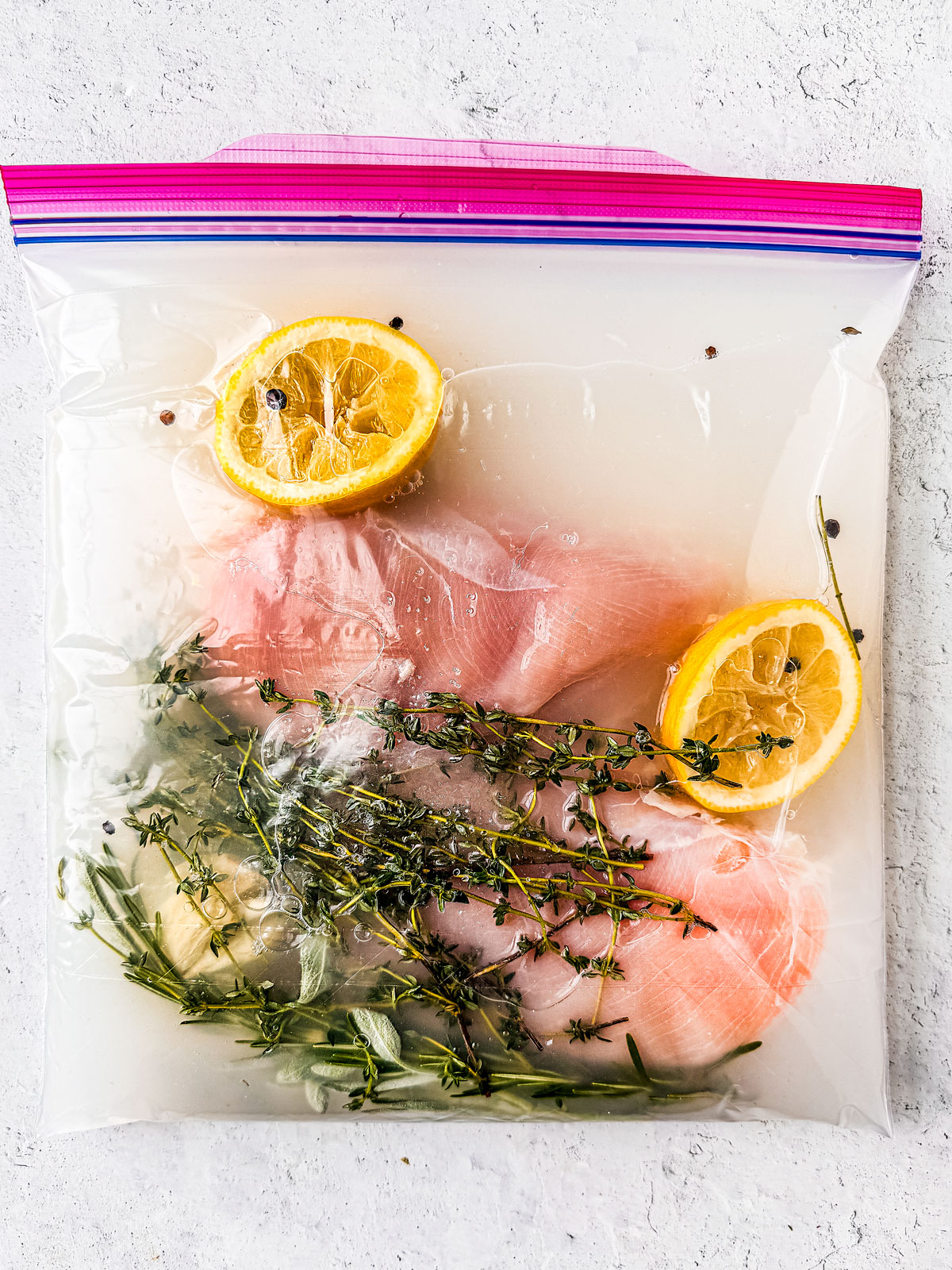
Table of Contents
Why You’ll Love This Method
Brining chicken is an absolute game changer. Not only does it add flavor, but it does wonders for texture and moisture. If you’re a person who worries about bland and tough overcooked chicken, brining will be your ticket to confidence when dealing with poultry. So read on, and go wow your family!
Is It Worth Brining Chicken Breasts?
Absolutely, yes! Brining a full bird like, like with this turkey brine recipe, seems to be more common. But giving chicken breasts a short bath in brine yields great results every time, whether you’re grilled Moroccan chicken skewers, pan frying a cashew chicken recipe, or doing some air fryer chicken tenders. It helps the chicken retain moisture and it gives you some security in knowing that even if you overcook your chicken a little, it will still be juicy and delicious.
Brining vs Marinating
There’s a BIG difference between brining and marinating.
- Brining penetrates the meat resulting in moisture retention and flavor deep within.
- Marinating just adds flavor to the exterior of the chicken without doing anything to its interior. A marinade does not make chicken more tender or juicy—the whole concept has been debunked.
What Is the Formula for Brine?
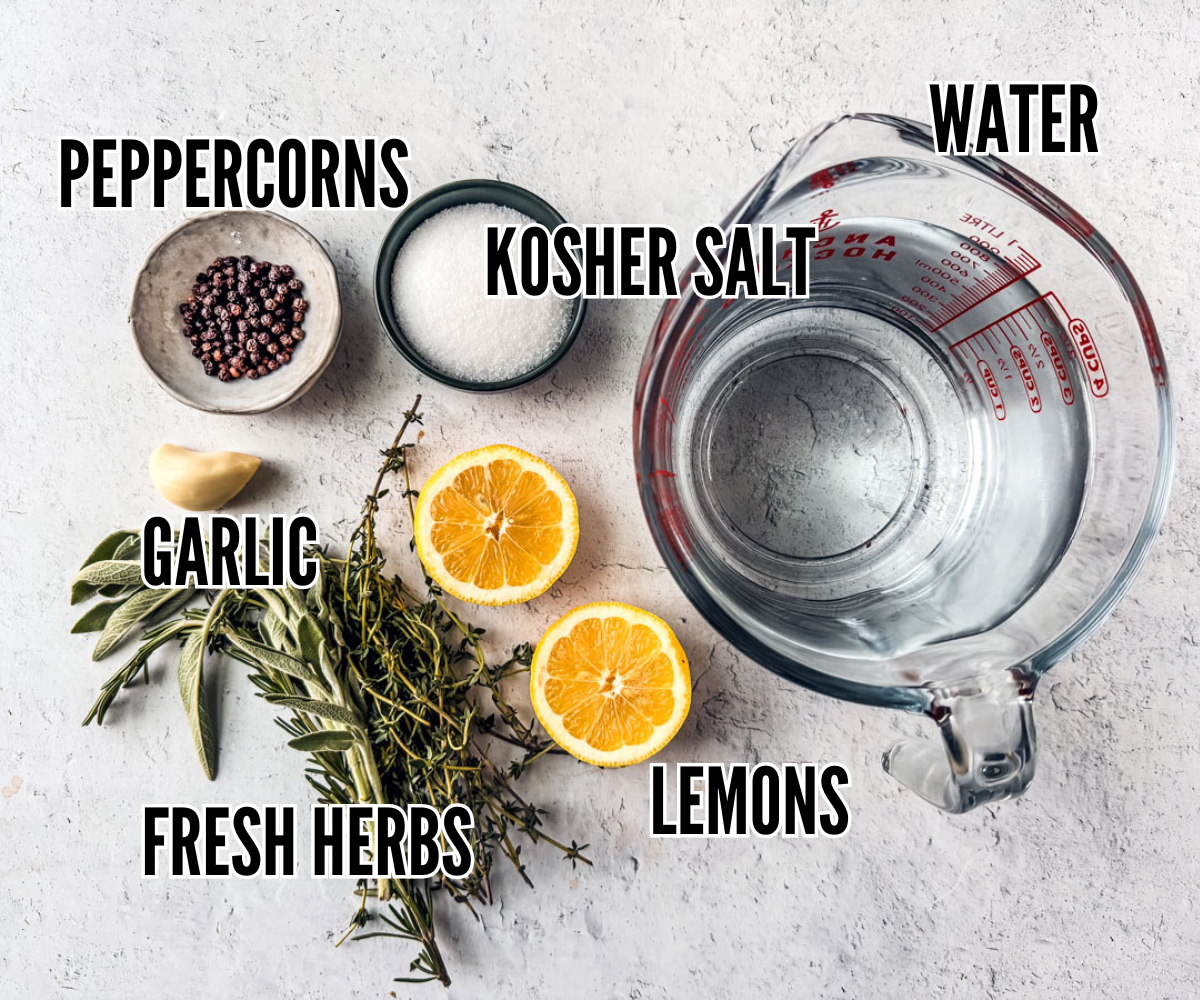
For a simple brine, 1 tablespoon of salt for every 1 cup of liquid is all you need. Of course it’s nice to amp it up with some herbs, citrus, and spices for added flavor. This will yield a nicely seasoned bird!
Here’s what I use in my brine:
- Liquid. If I’m just brining chicken breasts, I’ll use water unless I have some apple cider or apple juice on hand, which is what I like to use in my turkey brine recipe around the holidays.
- Salt. Coarse kosher salt works great as it dissolves in water very well. But fine sea salt or canning & pickling salts work too.
- Citrus fruit. Lemons or oranges are perfect. Just squeeze in the juice and throw the fruit wedges in with everything else for extra flavor.
- Fresh herbs. I like using potent aromatic herbs like thyme, sage, rosemary, and oregano.
- Garlic cloves. You don’t even have to peel them; just smash them with the broad end of a knife and throw them in.
- Peppercorns.
How to Brine Chicken Breasts
Warm 2 cups of water in a pot on the stovetop and stir in the salt. You don’t have to bring the water to a simmer, just warm it enough to properly dissolve the salt. Then remove the pot from the heat and add 2-4 cups of cold water to it to cool it down. If you really want to speed up the cooling process, add some ice to it. You want the water to be cool before placing the chicken into it.
While the water cools, prepare your brining bag (see list of useful equipment below) by squeezing your citrus into it, then pop the remains of the fruit into the bag along with the fresh herbs, smashed garlic clove(s), and peppercorns.
Prop the bag into a large mixing bowl for support, and carefully pour the cooled brine into it.
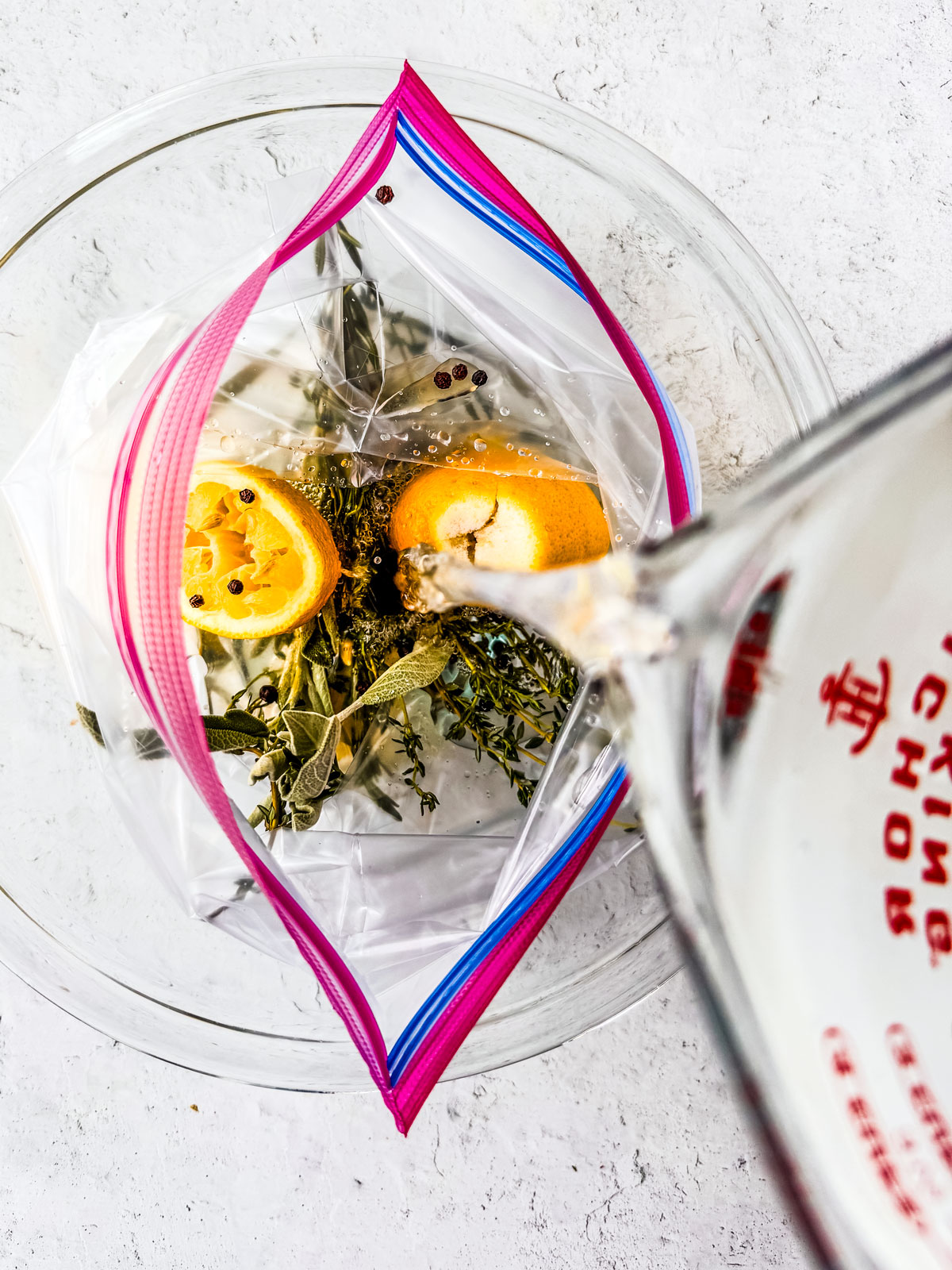
Using tongs, submerge the chicken into the brine. Push out what air you can, and seal the bag well.
Place the bag into the fridge for at least 30 minutes, up to an hour. (You don’t want to over-brine the chicken or it will become too salty and the texture will degrade, becoming almost spongey.)
After brining, carefully rinse the chicken breasts in the sink with low water pressure so that bacteria doesn’t spread and splatter, then transfer to a paper towel-lined plate to gently pat dry.
Quick Tip
Be sure to disinfect your sink after you rinse the chicken off in it. I really like this cleaner! It’s non-toxic and food safe.
Useful Equipment
- A vessel for brining, like a gallon-sized freezer bag or a large bowl with a lid.
- Small saucepan
- Tongs
Frequently Asked Questions
Skinless, boneless breasts should be marinated for at least 30 minutes and no longer than 2 hours. I find that 1 hour has the best outcome. Bone-in chicken breasts can be marinated for up to 3-4 hours.
Yes, you can make it a few days in advance. Be sure to keep it in a sealed container in the fridge.
No! Once the brine has had raw chicken in it, consider it contaminated. It’s not good to reuse any meat brine from a food safety standpoint or for flavor.
Yes. I’m not the type of person who washes chicken prior to preparing it for food safety purposes, but after brining, you want to remove excess salt on the exterior or you’ll end up with an extremely salty dinner.
Recipes to Use Brined Chicken
- Easy Chicken Piccata
- Easy Chicken Marsala
- One-Pan Salsa Chicken and Rice
- Grilled Moroccan Chicken Skewers
Have You Used This Recipe?
If you enjoyed this recipe, please consider leaving a STAR rating & commenting below with feedback!
You can also show off your creations on Instagram by tagging @killing__thyme
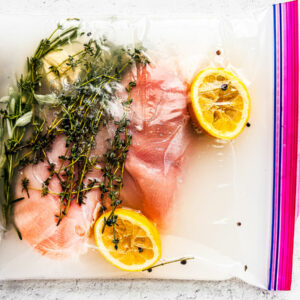
How to Brine Chicken Breasts
Ingredients
This is for 2 chicken breasts. See notes for adapting the recipe for more chicken breasts.
- 2 boneless, skinless chicken breasts
- 4 cups water
- 4 TBSP kosher salt, Fine sea salt or canning & pickling salts also work.
- 1 citrus fruit
- A handful of fresh herbs, such as rosemary, thyme, oregano, sage, bay leaf, etc., You can use combination of these herbs and there is no set measured amount. A handful is fine.
- 2 Garlic cloves, smashed
- 1 tsp peppercorns
Instructions
- Warm 2 cups of water on the stovetop in a pot. (You don't want to bring it to a full simmer, just warm the water enough to properly dissolve the salt.)
- Add the salt and stir. Once the salt has dissolved, remove the pot from the heat.
- Add 2-4 cups of cold water to it to cool it down; if you want to speed up the cooling process, you can add a handful of ice to it. Make sure the water is cool before placing the chicken into it.
- While waiting for the water to cool down, prepare your brining bag. Squeeze the citrus fruits juices into it, then put the remains of the fruit into the bag along with the fresh herbs, smashed garlic cloves, and peppercorns.
- For support, prop the bag into a large mixing bowl and carefully pour the cooled brine into it.
- Transfer the chicken into the brine using tongs, ensuring that the breasts are fully submerged. Push out as much air as you can from the bag and seal it well to prevent leaks.
- Pop the bag into the fridge for at least 30 minutes, up to an hour. (You could leave it for up to 2 hours, but you don't want to over-brine the chicken or it will become too salty and the texture will degrade and become spongy. I find that 1 hour is the sweet spot.)
- When the brining is done, carefully rinse the chicken breasts in the sink. Do this with low water pressure so that bacteria doesn’t splash and spread.
- Transfer to a paper towel-lined plate and gently pat the breasts dry with paper towels, then proceed with your chicken recipe. You'll be thrilled with how tender, juicy, and flavorful your chicken is!
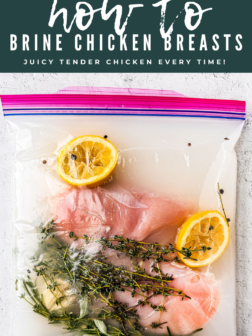






This is a great recipe. I wonder if I could brine the chicken and then freeze it? Does it retain it’s tenderness?
Hi Mavis! Yes, you can freeze the chicken post brining. Freezing always decreases the quality of the texture in food at least a little, but you’ll still end up with a tasty chicken!
Produces lovely moist chicken every time.
So happy to hear this, Naomi!
Fantastic chicken brine recipe! Thank you! I’ve used your turkey brine recipe two years in a row for thanksgiving but never thought to do small batch with chicken breasts. Lovely result.